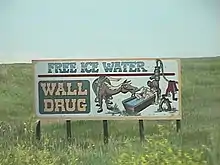Tourist trap
A tourist trap is an establishment (or group of establishments) that has been created or re-purposed with the aim of attracting tourists and their money. Tourist traps will typically provide services, entertainment, food, souvenirs and other products for tourists to purchase.[1]



While some establishments may be viewed by tourists as fun and interesting diversions, tourist traps can also have negative connotations when they direct travelers off highways into commercial areas, and could potentially be tacky, deceitful and an overall waste of time and money.
Sight Markers
Attractions for which the tourist traps target are said to be brought about by sight markers. [2] A sight or object becomes an attraction when a marker is placed. The marker serves the purpose of promoting or advertising to indicate where an attraction is located. As a result, less known sights placed by well known sights are made visible. [2] It is not uncommon to see tourist traps placed among well known attractions to take advantage well established sight markers. A tourist trap of this nature has been placed in the USA upon the convergence of four states – Utah, New Mexico, Colorado and Arizona. Surrounding this point of attraction are souvenirs and services, a casino and a recreation center operated by the Navajo people who earn profits from visitors of the Four Corners Monument.
Tourist Traps Trends
Tourism is constantly changing with observable social, economic and lifestyle trends in society having an influence. What was once old and traditional tourism centred around the three S’s (Sun, Sea, Sand), the new tourism has said to now focus on the three E’s (Entertainment, Excitement, Education). [2] Tourist traps take advantage of these trends with deceit. Whilst appearing to be an authentic product of cultural tourism, tourist traps have an underlying low cultural value. [2]
Australia
There are a large number of "big things" in Australia. Many of those were initially created as tourist traps, but have gained cult status in the country since.
Canada
Clifton Hill, Niagara Falls is a popular tourist trap in Niagara Falls, Ontario. The street attractions are owned by two entities. The area also extends to a small portion north of Victoria Avenue east and west of Clifton Hill and Centre Street north of Victoria Avenue.
United States
In some areas, simple facilities may be a sufficient draw to entice tourists to stop. Wall Drug, in South Dakota, began its tourist trade by offering free ice water.[3]
Breezewood, Pennsylvania represents a physical tourist trap at the intersection of Interstate 70 and Interstate 76, where the two major highways are not directly connected; forcing transiting drivers off the interstate and "into several suddenly urban blocks with traffic lights and a dense bazaar of gas stations, fast food restaurants and motels."[4]
South of the Border is an attraction on Interstate 95 (I-95), US Highway 301 (US 301) and US 501 in Dillon, South Carolina, just south of Rowland, North Carolina. It is so named because it is just south of the border between North Carolina and South Carolina, and was the half way point to Florida from New York in the early days of motor travel. The area is themed in tongue-in-cheek, faux-Mexican style. The rest area contains restaurants, gas stations, a video arcade, and a motel, and truck stop as well as a small amusement park, a mini golf course, shopping and fireworks stores. Its mascot is Pedro, a caricature of a Mexican bandido. South of the Border is known for its roadside billboard advertisements, which begin many miles away from and incorporate a mileage countdown to the attraction itself. The stop has since fallen on hard times as more modern hotel areas have grown along I-95.
A few establishments take pride in the term and embody it into their names, such as "Da Yoopers Tourist Trap",[5] run by the comedy troupe Da Yoopers in Michigan’s Upper Peninsula, and "The Tourist Trap"[6] at Deep Creek Lake, Maryland.
The Tourist Trap Model
The tourist trap model is used in economics to describe the cost incurred as a tourist due to the limited information they have when buying a good/product. As a result, goods become overpriced and tourists are left exploited due to price uncertainty limited budget to cover search cost (e.g. time). For more information, See Chapter 5 of: Managerial Economics/Economics of advertising
See also
- The Big Texan Steak Ranch, "free" 72 oz. steak
- List of confidence tricks, including some that are aimed at tourists
- Gift shop
- Overtourism
- Roadside attraction
- Tourist attraction
- Lists of tourist attractions
References
- Gaines, Barbara K.; re (May 31, 1986). Idiomatic American English: A Step-By-Step Workbook for Learning Everyday American Expressions. Kodansha International. p. 85. ISBN 0-87011-756-4.
- Kruczek, Zygmunt (2010). "Cultural Tourism Dilemmas". 43 (3): 144–150. Cite journal requires
|journal=(help) - "WallDrug.com" (web). The Wall Drug Store got its start during the Depression years by offering Free Ice Water to thirsty travelers. 2007. Retrieved 2008-02-04.
- Savage, Charlie (2017-02-06). "As Trump Vows Building Splurge, Famed Traffic Choke Point Offers Warning". The New York Times. ISSN 0362-4331. Retrieved 2017-02-06.
- "Da Yoopers Tourist Trap & Museum" (Web). Ishpeming, Michigan, Business web site. Retrieved 2007-03-21.
- "The Tourist Trap" (Web). Deep Creek Lake, Maryland, Business web site. 2003. Retrieved 2007-03-21.